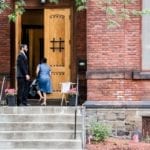This article originally appeared on Them+Us Media
A small group of Black Lives Matter protesters line up in front of a white picket fence on 4th Street in Lansingburgh, a neighborhood in Troy, on June 29. The pastel sky is gradually fading and the scene is tense with anticipation.
The protesters are lined up outside an innocuous-looking brick church. A sign in gothic lettering reads “Grace Baptist Church.” The church’s service hours are listed, and though the protesters are here on a Monday, there are no Monday hours written on the sign.
This is a special occasion.
What will happen tonight will make national news. It is still being talked about by conservatives, weeks later. Right-wing figures like Dinesh D’Souza, Nigel Farage, and Mike Cernovich all will retweet videos of tonight’s confrontations with predictably incendiary commentary. An unflattering picture has been painted by these commentators of the protesters. The protesters now are, to many conservatives across the world, seen as boorish, uncivilized creatures, who entered a church in order to bother and intimidate the congregants within.
To be fair, the protest did get rowdy on Sunday morning. There was a tussle between protesters and congregants, although footage from the scene doesn’t paint a clear picture of who instigated the altercation.
And to be fairer, the protesters who entered the church on Monday night were rude. They held up fists of solidarity while John Koletas and another preacher spoke, interrupted the sermon with comments, and as they left, spat insults at the congregants as they left the service.
But the narrative circulated by the right-wing doesn’t tell the full story.
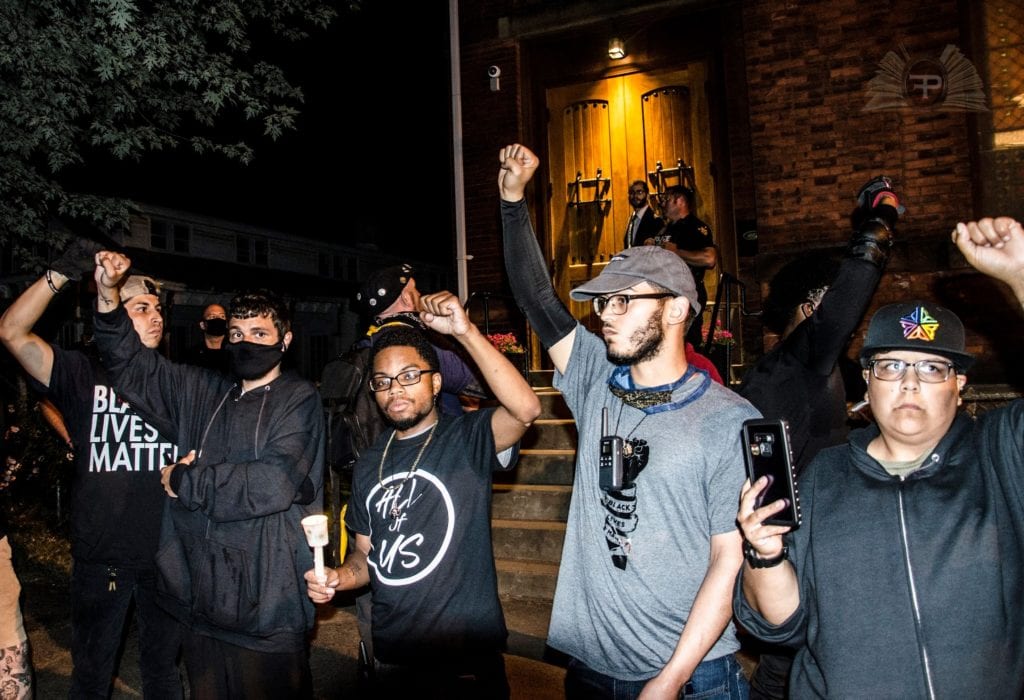
For starters, GBC isn’t any old Baptist church. This was not a normal congregation that was invaded, willy-nilly, by a liberal horde of Black Lives Matter protesters. The GBC has amassed notoriety in the last few weeks for their viscerally right-wing views and for their hatred of Black Lives Matters protesters. Also on the list of groups they have reviled or vilified: Muslims, queer people, career women, Native Americans, liberals, Catholics, other Protestants, and Jews.
In the Capital Region, they’ve been controversial for years.
Most recently, John Koletas and his church have become infamous for raffling off an AR-15 rifle, in a city that’s seen a spate of gun violence and death in the last few weeks. He’s done this a few times before, in 2014, again in 2017. But this year, he did so in the midst of a global backlash to racism and police brutality in a city and region that has seen its own antiracism uprising take place over the last few weeks. Handing out rifles at this time — it’s seen, by activists, and well, a whole swath of neighbors and Troy residents, as an affront.
The GBC has not responded to requests for comment.
Most notoriously, probably, is the requirement that one can only enter the church if one touches a slice of pork. On the church steps, there is a paper plate with slices of raw hot dog. A laminated sign reads: “NO ONE IS ALLOWED TO ENTER HERE UNLESS THEY FIRST TOUCH THE HAM, PORK, SWINE.” (“Swine” — the affectation of this word seems to be very attractive to the church. They declare it to be a “Bible word,” on their website.)
This has sparked plenty of outrage, on the part of protesters. The “swine” is John Koletas’ way of warding off Muslims, although special dispensation is given to some Orthodox or Hasidic Jews who can choose to not touch the meat.
The first AR-15 raffle that took place in 2014 even boasted Republican Steve McLaughlin, who was then a state assemblyman, as a featured guest. At the event, McLaughlin lauded the church for protecting its constituents’ right to bear arms.
McLaughlin, now Rensselaer County Executive, wasn’t at this year’s giveaway. (He didn’t return Them & Us Media’s request for comment.)
But the defense of the Second Amendment is only one of many political values this church holds. On the back of a church handout titled “Understanding Tax Cuts,” it endorses a hodgepodge of libertarian, populist, capitalist, and socially conservative ideas, blending politics and religion into a special mix that’s even abnormal for some Christian fundamentalists.
Back in 2014, local press honed in on what was already an arguably politically-charged subject: an AR-15 church raffle. It was less than two years removed from the Sandy Hook Elementary School shooting carried out by an AR-15 shooter, which left 26 children and two adults dead.
Organizers viewed GBC’s rifle giveaway as a dangerous and inappropriate action in a city that has been plagued with gun violence. On June 5, Donnovan Clayton was gunned down while coming home on 6th Avenue in North Central, a neighborhood just south of Lansingburgh. On May 17, Rafael Caraballo was killed by gunfire on 5th Avenue in Lansingburgh. In January, in the same Troy neighborhood, a 17-year-old resident was injured from a drive-by shooting on 6th Avenue.
But protesters were motivated, this time around, by more than just the AR-15 raffle. Within the last six years, John Koletas, who has become more visible recently, has said offensive things in his sermons, which are widely distributed on YouTube.
Here are some examples from prior sermons in the chart below:
| What has John Koletas said about … |
| The N-Word | “Should we not say Niger or Nigeria where Black people have originally originated from the land of Africa?” (x) |
| Interracial marriage | “I’m a bigot. Look up the definition in the dictionary. I’m a bigot. I’m a racist. I think the races should be kept separate as much as possible. I think you ought to marry your own if you can.” (x) |
| Mexico | “I ask you this question: Why did God bless America and not North America and he didn’t bless Mexico?” His answer: Catholicism. (x) |
| BLM riots and protests | “Oh, maybe if you become their slaves or kill yourself, that may appease them. No. Africans were killing each other before white men ever stepped in there.” (x) |
| Native Americans | (This is a continuation of the pastor’s quote above.) “The savages in America here were killing each other before the American white man ever came in. You know why? Cause’ sin! Sin!” (x) |
| Healthcare | “The government’s extending the life of stupid people who smoke weed, smoke cigarettes, drink liquor, drink alcohol, and take prescription medications are addicted while penalizing capitalists, entrepreneurs, businessmen, and free enterprise.” (x) |
| LGBTQ community | “When your son or daughter becomes a queer, a pervert sodomite, instead of you believing what God said — ‘It’s my son. I’m going to support anything my son or my daughter does.’ You’re a stupid idiot, man. You’re a stupid idiot.” (x) |
| Muslims | “Now, listen. I don’t think we ought to allow any Muslims into our country because if you believe in the Sharia Law and you believe what Mohammed taught, it’s incompatible with the Constitution.” (x) |
| The Pope | “The Pope is the most evil person on Earth.” (x) |
| Career women | “A career woman would have to go home to teach and her own children? Why is that a bad thing?” (x) |
| Troy, New York | “Anybody live in the Troylet? You’ll probably say that 99.99% of everything is bad. But there’s a city that God’s building. Amen.” (x) |
| Mocking COVID-19 vaccine | “OK, so the vaccine has a little bit of a drug in it. So OK, so it might have a chip in it. OK, so it might have some other stuff in it. Don’t you care about everybody else that might catch the disease and die?” (x) |
| History months | “Black History Month means communism and Marxism month. Women’s History Month means man-hating and God-hating month. Sodomite History Month is a straight-hating month. American Native Savages Month — they’re gonna make one, too.” This is a continuation of the pastor’s quote on interracial marriage. (x) |
In an era of heightened racial tension, in this incredibly fraught time in the Capital Region and across the nation, a church like GBC was bound to draw some protest.
And GBC likely isn’t going to stop drawing controversy.
The events of the morning of Sunday, June 28 were ugly.
“Why are you so angry?” John Koletas said, standing a safe distance from protesters.
“We’re angry because people are dying,” yelled a protester. “How is that not clear?”
“People die every single day,” the pastor said, in a matter-of-fact way.
Members of GBC lined the church steps, like guards. Among the GBC standouts was the pastor’s son, John Koletas Jr., a young man who wore a Confederate flag belt buckle and long-bearded man with a yarmulke that read “PB.” By and large, the congregants remained mostly tranquil. It was a move that ultimately painted an innocuous image of GBC’s members. They were seen as stoic, harmless, even gentle, while the protesters, on the other hand, catapulted insults from across the street.
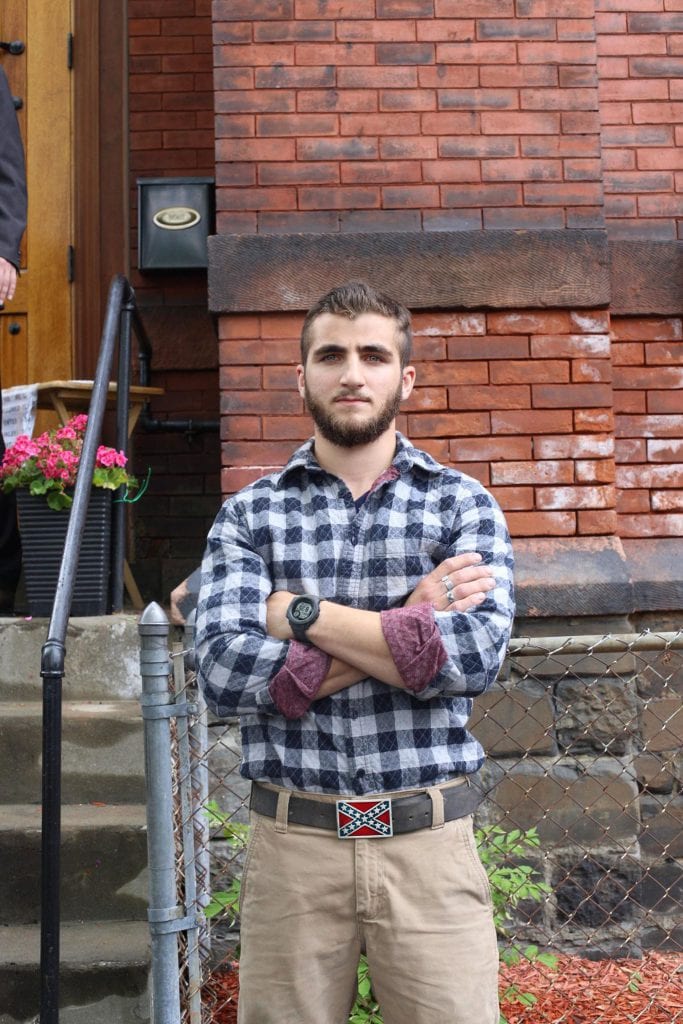
The scene grew increasingly dangerous as the two crowds pressed closely together. Church members were jeered as they entered the building, including — and this is what right-wing media has honed in on — parents and some of GBC’s Black congregants. The crowd chanted “save those kids” while blocking the entrance.
Protesters stood in front of the entrance with fists of solidarity held in the air. Koletas screamed for police to assist him, to clear the entrance into his church. The two crowds started to push against each other.
A protester shouted that they and their compatriots had the right to go inside.
Fists flew.
“We aren’t here for violence”…as they pull church members off the steps and punch them in Troy, NY.
— Grace Baptist Church (@realgbctroyny) June 29, 2020
Why is the media demonizing Bible believers while calling the mob peaceful? pic.twitter.com/2JAffFqxAR
While the protesters remained non-violent throughout much of the rallies that occurred on Sunday and Monday, the optics had been indelibly marred. The viral moment created by the confrontation was ripe for consumption by conservative and alt-right media.
John Koletas held a second AR-15 rifle raffle only a day after his first.
On July 5, the senior Koletas would tell his congregation that the protests had illuminated the differences between what he sees as God-fearing followers of his church, and, well, everyone else.
“You could not have seen a better picture of the enemies of God and the people who love God,” the pastor would say. About interactions with protesters, he would say, “we could not have planned it any better.”
And at the Monday protest, he didn’t bar those enemies from coming inside. They didn’t storm inside, either. The GBC allowed them to peacefully enter. Even after a brief skirmish, John Koletas not only permitted but urged “everyone” to remain.
There’s a small group of men and women who are closely gathered inside the church on Monday evening. They are congregants; members of GBC. They shake each others’ hands. None of them are wearing face masks (only one congregant will don a face mask, and only in the second half of the worship service despite a pandemic still flowing through New York State).
Near a table, a smiling woman, who is draped in a headscarf and wearing a modest denim jacket, has attendants sign an agreement. It states that the guest agrees that no recording devices are allowed. That the church holds no responsibility if a guest catches COVID-19, and a disclaimer that says that if you “do not like GBC”, among other factors, you lose eligibility for the contest.
Photo identification is required to win the contest. The winner must go through a federal background check.
The majority of the congregation appears to be middle-aged to elderly and white with a few exceptions. There will be several Black congregants in the pews during the service despite John Koletas’ history of racist remarks.
Many women have their heads covered during the service while wearing long dresses or long skirts; there’s a mix of men in semi-formal or casual attire. One of the church’s maxims listed online is that “modest apparel should be worn by believers.”
Frequent churchgoers Leslie and Mary Safford socialize with the congregation, before going further into the church. Mary Safford is wearing a blue headscarf and dress clothes that match; Leslie Safford, a bald, stocky man with a salt-and-pepper beard, won an AR-15 from the 2014 giveaway. They’ve both been members of the congregation for about 15 to 20 years.
The pews are padded with lemon-colored cushions. Small patches of milky-white paint peel off the ceiling like sunburned flesh. Behind the pulpit, there’s a stained glass window and an American flag drapes down it. There’s an old-fashioned church organ on the left side of the pulpit and a painting of a wooden cross on the right.
“O Χριστὀς Ανἐστη” reads a sign on the pulpit. It means “Christ is risen” in Greek.
John Koletas steps up to the podium and heartily greets his congregation. He asks those assembled to sing a hymn.
“293, let us all stand up … unless it’s against your religion and you don’t want to touch the ham,” he says.
After the hymn, a congregant leads a patriotic prayer, showing gratitude for both the pastor, GBC, and the Founding Fathers.
“And now the moment most people came here tonight are waiting for,” says John Koletas, anticipation in his voice. “A very dangerous weapon.” He crouches down and opens a large black rifle case lying on the floor beside the pulpit, and pulls out not a rifle, but a King James Bible, in the manner of a magician yanking a rabbit from a hat.
The congregants laugh and laugh, they let out a few gleeful hoots.
John Koletas steps aside, and Daniel George Koletas, his 31-year-old son, takes the mic. The younger Koletas, who is mostly known by his middle name, is a thin man with black tinted glasses and a slightly receding hairline, similar to his father’s.
He scornfully describes the crowd outside as miserable.
“You would think they were the ones being persecuted,” he says.
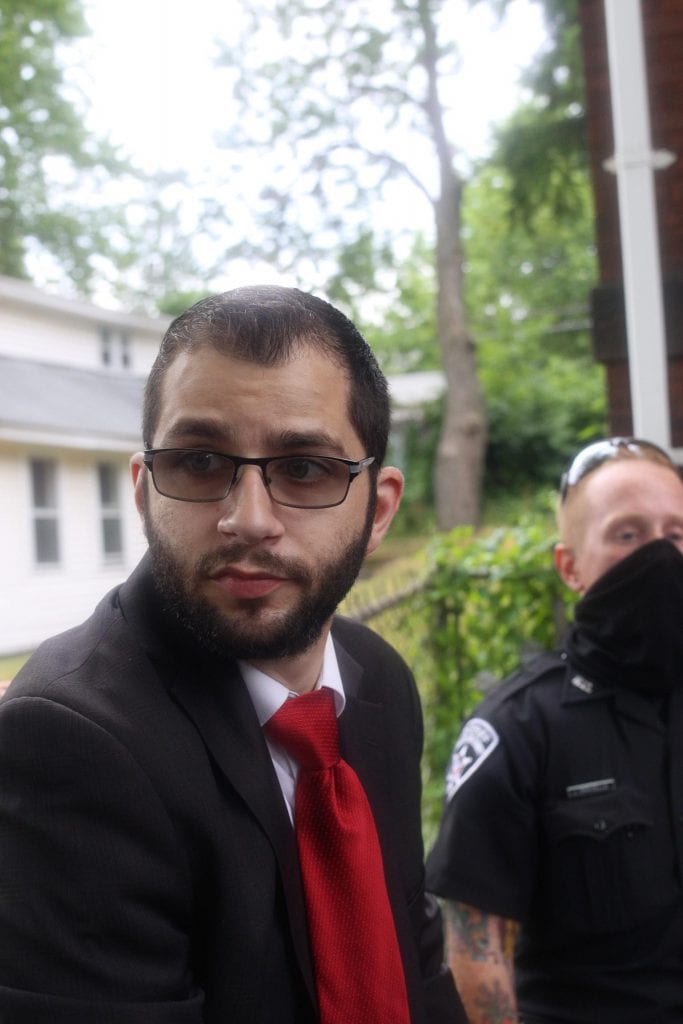
Photo courtesy of Chris Canfield.
The sermon that ensues is fire-and-brimstone, accompanied by swinging hand gestures and lines shouted into the microphone. During the sermon, he calls the protesters cowards. He calls them hoodlums, and their assembly a congregation of evildoers.
Then George Koletas tosses out some tropes you might hear a Fox News pundit say. They include: Black people have privilege over white folks; no one can joke about “homos and queers” at construction sites anymore without receiving backlash; and, of course, eternal hellfire awaits protesters if they don’t convert. He alleges that social justice activists want to “destroy” fundamentalist Baptist Christians.
All eyes are transfixed on the younger Koletas; the crowd is enraptured. He warns his father’s congregation that this is just a trial run.
“There’s going to come a time that the government’s going to tell you to take a knee to the king’s decree,” he says. Amens are fired from the audience, scattered like buckshot. Sitting in a chair next to the pulpit, the senior Koletas raises an arm in the air whenever George lands a particularly good line: he smiles serenely, a proud father.
Nationalism is the connective tissue that strings through this sermon. Imagery and rhetoric ripped straight from the Revolutionary War suffuse it thoroughly. GBC references patriotic legend nearly as much as they lean on the King James Bible. They, and all followers of the KJV Only movement, believe that the 1611 English translation of the holy book is the best one ever produced and that all further versions are corrupted.
In between scripture readings, the congregation belts out America the Beautiful and listens to a reading of Patrick Henry’s address to the Second Virginia Convention. John Koletas’ rendition of Henry’s climactic “give me liberty or give me death” rings through the hall.
Next up: a man with a beard and a receding hairline. He’s stockier than the father or the son. On the pulpit, his sermon is less familiar, less tinged with twang in his preaching than that of the father and son. He’s Rev. Scott DeGiorgio of Faith Baptist Church in Petersburgh, and a close friend of John Koletas.
DeGiorgio looks out to the back of the congregation, where a line of protesters stand with fists of solidarity in the air.
The audience has grown.
“Well, it’s just about to get fun,” says DeGiorgio from the pulpit.
“Amen!” belts a member of the congregation.
Some congregants rush up the aisle, forming a human barrier in the lobby. Those remaining in their seats take short glances behind them.
John Koletas grew up near Philadelphia. His home was in a majority Black neighborhood, which he has referenced in sermons.
Greek immigrant Athanasia Koletas was his mother. His father, William Koletas, was a Greek American, and they were practicing Greek Orthodox Christians. John Koletas was bussed to Lower Merion High School in a majority Jewish neighborhood. He graduated in 1975.
The pastor has described his younger self, in sermons, as angry, hateful, bitter, and “a communist.” The then-21-year-old was bombarded with gospel tracts for months by a classmate from Rutgers University. He accepted her offer to tag along to church in Hackensack, N.J. after she showed him several passages from the Book of Romans.
By late 1978, he declared himself reborn. It reportedly soured his relationship with a number of family members, who still practiced Greek Orthodox Christianity.
John Koletas became immersed in conservatism as soon as he became a Christian fundamentalist. A daughter of the preacher said in a July 5 podcast interview for Preacher Boys, that John Koletas made a vow to God to join the Marines if Ronald Reagan won the 1980 presidential election.
Reagan did, so John Koletas did as well.
“I don’t think there’s any [Independent Fundamentalist Baptist] pastor that’s more conservative than my dad and my dad’s very proud of that,” she said on Preacher Boys. “He’s stricter than all of them.”
His daughter on the podcast believes a 1983 tragedy radicalized the pastor’s worldview further. That was the year his mother was fatally shot by his father. William Koletas reportedly never apologized to his son during prison visits.
“Even more so than him becoming a believer and renouncing Orthodox [Christianity] and going IFB, I think his mom being killed — being murdered basically in cold blood really basically shaped a lot of how my dad to this day thinks, believes, preaches, reacts to everything,” his daughter said. “And I mean, that’s a lot of trauma right there to work through.”
After learning that the Capital Region didn’t have an IFB church, John Koletas was interested in starting his own congregation. One day, he traveled around the area for six consecutive hours with Rev. Dick Troell, a Sunday School volunteer. When he visited the Collar City, it reminded him of his own beginnings.
God brought John Koletas to Troy, according to him.
The pastor started a fundamentalist congregation at the Troy Boys Social Club in 1987. He moved into a shingled building at 736 3rd Avenue in Troy a year later. John Koletas funded the church on his own while working as a court reporter for the state Supreme Court’s 3rd Judicial District.
He amassed a congregation of about 70 people by 1990. According to his daughter, the congregation, in the early years, had a high turnover rate.
In an interview, a former congregant from GBC’s early history told Them & Us Media that he wants the church to end. Beginning to question religion, Randy Harlow, who is now an atheist, ultimately left GBC at the age of 18. Since then, he believes it’s become more extreme.
“When you lead this whole congregation, you get this extreme power,” Harlow said. “We are, as a community, saying no, but is it going to be enough?”
Harlow lived on the same street as GBC while growing up in the 1990s. One day, he remembered being enticed into the church by the promise of free food. The church would hand out treats whenever a student got an answer right in Sunday School lessons. This perk, along with being able to loudly shout during sermons, kept him loyal to the congregation.
As he grew older, a recurrent aspect of the pastor’s preaching seemed more and more bizarre: John Koletas flaunting his arrest record in sermons.
From 1989 to 1990, John Koletas was arrested seven times on charges of disorderly conduct while loudly preaching in the streets of Troy. He even unsuccessfully filed a $485,000 lawsuit against the city for infringing on his Constitutional right to preach on the street.
A black and white cover photo on the church’s Facebook page shows a younger John Koletas. Protesters rally behind him. One has a sign that reads “BAN PORN NOT PREACHERS.”
The Black Lives Matter protesters mill outside the church, while the sermon is on. They chant “no justice, no peace.” They joke about what must be happening inside. A Jewish protester languidly starts to sing the mourner’s kaddish, the prayer for lost lives.
At some point, a protester tries to enter the church, and an officer with the Troy Police goes inside to discover whether outside protesters are allowed to attend. After a while, the officer comes out, and informs the protesters that they are allowed in, as long as they touch the “swine.”
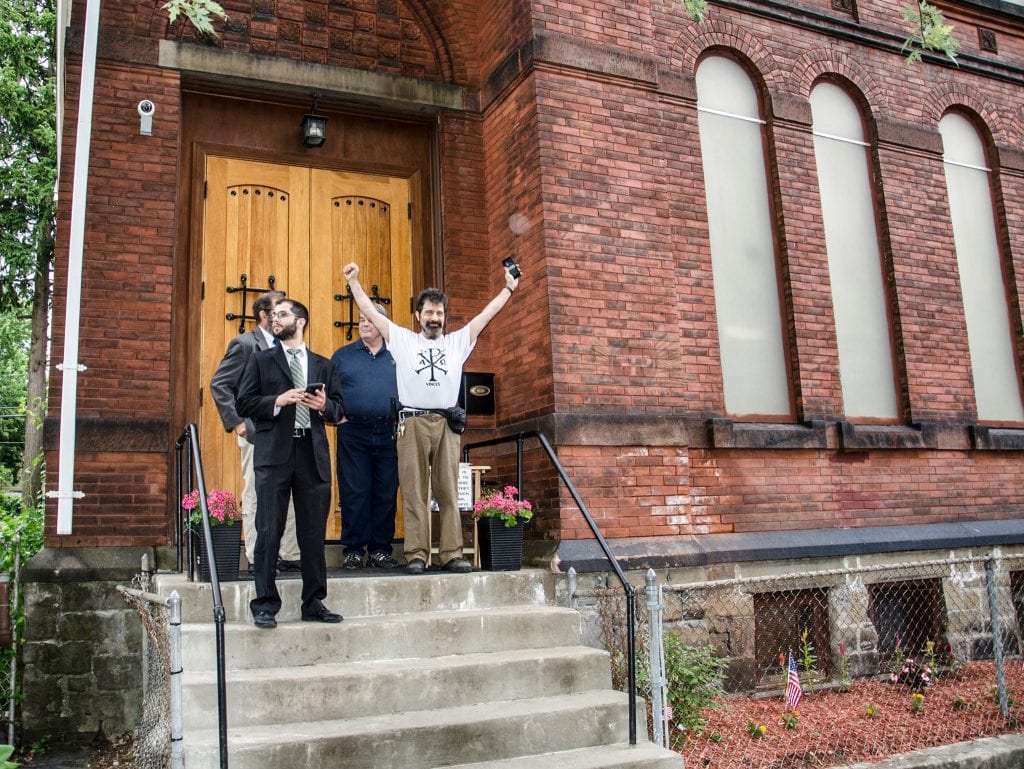
George Koletas comes out to watch the protesters as they line up, as they dutifully touch the hot dog slice, and as they enter the church.
Steven Negron, a member of the volunteer security force for Capital Region Black Lives Matter protesters, starts to climb the steps leading to the church but soon decides against it. Uncomfortable, Negron tells Forbes that he’s going to keep the outside crowd under control instead of moving further into the church.
“It wasn’t so much because of their ridiculous stipulations to gain entry,” Negron said in a later interview. “It was more or less, I stepped foot on those steps, and my gut did not feel well.”
Days after entering the church, another protester, Legacy Casanova, wrote in a public Facebook post that he felt like crying following his experience inside GBC. Casanova said that walking in the church did something to his “soul and spirit.”
It’s the protesters’ first encounter on John Koletas’ turf. Tensions simmer as they enter.
While DeGiorgio gives his sermon, the protesters kneel by the entrance, in protest, not prayer. They raise their fists in solidarity in the back of the room.
According to Forbes, a congregant, a bearded man with dark gray hair wearing a raggy white t-shirt and beige pants, held an electric billy club and he let out a few zaps, seemingly to intimidate the protesters.
“Our nation formed so we would not be persecuted for preaching Christ,” says DeGiorgio, from the pulpit. “We’re faced with persecution, loudly from the citizenry, but more importantly … the government.”
With a steady, unshaken voice, DeGiorgio makes a conspiratorial appeal for salvation: if GBC doesn’t change, a governmental force will torture and imprison members, but if GBC changes, God will punish them. DiGiorgio never specifically mentions the demands to defund the police, but he says he should be left alone by law enforcement, and that they should be there when needed because, well, the citizenry pays them via taxation.
Thunderous applause makes it sound like a full house, but in reality, empty seats dot the room. A number of protesters fire back at the preacher’s anti-government, pro-freedom speech with rounds of what appear to be satirical “amens” and applause. But according to Forbes, several protesters weren’t mocking the sermon, but were actually agreeing with some of what DeGiorgio said about government oppression.
“We need to make sure that what I do in my house is none of your business and what you do in your house is none of my business,” DeGiorgio preaches. “Now, listen. If you show up at my house and you’re not welcome there, the first thing that I have the right to do is tell you to leave and if you refuse, shoot you!”
In what appears to be a long-winded comparison to allegations against the protesters, the preacher claims that he’s “never gone into anybody else’s house uninvited,” damaged property, robbed them, preached in their “living room,” and called police on them for a difference in opinion.
“Because they’re just as free as I am,” DeGiorgio says. “You just live your life … and don’t mess with mine!” he continues, “I’ll live mine and you’ll live yours!”
“That’s liberty!” he screams.
“Preach, pastor. Preach!” Forbes cries out in an exaggerated tone.
A guffaw comes from the back. It’s Amy Jones, a community activist. She is laughing at DeGiorgio when he says that a left-wing mob is wrong. (A right-wing mob is wrong, too, DeGiorgio adds.)
“Get the fuck away from me!” says Jones, who is approached by George Koletas, who evidently wants Jones to stop mocking the preacher. A line of the protester’s security team moves into position to protect Jones.
In a later interview with the Sanctuary for Independent Media, Jones alleged that George Koletas asked her to leave and she refused.
Those sitting in the pews, who were once paying attention to the preacher, snap their heads back to look at something that feels like it could be the start of a disaster. But whatever happens, a tense truce is eventually established. The protesters slide into their place at the back of the church.
GBC is certainly not the most popular church in the neighborhood. But for most of its history, the church at 612 4th Street has been an uncontroversial place.
It was first operated by Baptists in 1880 under the name “John Street Baptist Church.” In 1887, the building was renamed “Millis Memorial Baptist Church” after a prominent church donor, Boston shipping mogul Lansing Millis. The church kept its name for over a century.
Following the 2006 death of Rev. Dorman Avery, a beloved fixture in the church, much of the congregation left. Millis Memorial staff struggled to pay the bills and make necessary repairs in the weathered building. Services continued until the bitter end, but eventually, the costs were too much to bear. Hoping to merge with a thriving congregation, the church’s Board of Trustees decided to search for new owners.
A number of churches expressed interest in the site, but didn’t follow through. And then Larry Cahrenger, a board member who coordinated the transfer, met John Koletas. Interested in the property, the pastor wooed Cahrenger and acquired the church through a $1 ownership transfer around 2012.
According to Cahrenger’s sister, Joyce Vealey, he privately expressed disappointment with GBC’s antics until his death in 2019.
Vealey, 79, went to the church for most of her life with her family. She remembers conventional, apolitical Baptist services, chock full of organ music and familiar faces.
“Like I said, my grandmother — her sister had like 9 or 10 kids and, of course, they all went there and their kids all went there,” Vealey said. “We all went there.”
When Millis Memorial reopened as GBC, Vealey and a handful of congregants attended a Sunday service. But John Koletas’ fiery nationalistic rhetoric wasn’t what they wanted. They walked out during the sermon.
“It makes me sick,” Vealey said.
Jones has just been effectively shushed, and the cold war between congregants and protesters is back on.
John Koletas angrily bans “Amening.” Calming down slightly, he then reassures the congregation that he wants everybody to stay and “be respectful.”
DeGiorgio comes back to the pulpit to finish off the sermon.
Minus the presence of the inside opposition, it briefly feels like an ordinary church service as the John Koletas directs the audience to sing along to a hymn, Jesus Saves, and afterward, read two Bible verses.
“The kings of the world and all the inhabitants of the world, would not have believed that the adversary and the enemy should have entered into the gates of Jerusalem,” the congregation reads in unison. “For the sins of her prophets and the iniquities of her priests that have shed the blood of the just in front of her.”
“And we are talking tonight about cowards, traitors, and betrayers,” John Koletas says before leading a prayer for the audience.
Standing still at the pulpit, the pastor talks about his beginnings. He claims to have been raised in a neighborhood that was 85% Black, a place where he learned to “fight and play basketball pretty good.” At the time, he said he was “anti-American,” angry, and bitter until he got saved.
“If I could’ve found a Turk, I would’ve killed him because of what the Turks did to the Greeks for 400 years as they were slaves,” he says. “I built that up because I heard the stories of the 400 years that the Muslims occupied Greece and burned them and roasted them on a pit.”
The pastor is referring to the Ottoman Turks, which enslaved Greeks and other Balkan peoples as well as Abyssinian, Zanj, Syrian, and Armenian peoples. Slavery was abolished under the Turkish Constitution in 1924, but illegal slave trading continued for years.
John Koletas spoke about his conversion, his beginnings in Troy, and the church’s initial outreach, including knocking on doors and his notorious street preaching. He pulls out his fist and says, “we knocked on project doors 100 times more than everybody back there combined,” and it’s clear he’s referring to the protesters in the back.
John Koletas declares he loves the Troy Police despite tangling with the department over street preaching. GBC, he says confidently, prays for them every week. He characterizes both law enforcement officers and Black Lives Matter activists as influenced by their respective higher-ups. (He doesn’t specify who those higher-ups are.)
Troy has been a powderkeg of racial contention for a while now. Tensions between the city’s communities of color and its law enforcement agency have been at an all-time high in recent years. The killing of Edson Thevenin in 2016 and the non-fatal shooting of Dahmeek McDonald in 2017, both by police, have built up a following of the city’s Black Lives Matter movement.
But despite the critical differences of opinion between protesters and John Koletas, the pastor still pleas for them to become “saved.”
“If I could, I’d get on my knees right now and I’d beg you to get saved tonight,” John Koletas says calmly and gets down on his knees and starts to shout. “Not for Black Lives Matter; not for Greek Lives Matter; not for Jewish Lives Matter; not for All Lives Matter — for your soul!”
His pitch continues for several minutes, citing hellfire as the alternative to not following the King James Bible and being “born again.” GBC members believe they are “born again,” a phrase popularly used in evangelicalism to describe gaining a personal connection with Jesus Christ.
According to a Gallup poll conducted between 2016 and 2018, 41% of Americans identify as born again or Evangelical.
The protesters are a blend of Christians, atheists, spiritualists, and at least one Muslim — Anthony Brown-Davis. In order to enter the church in good conscience, Brown-Davis wore gloves to touch the pork at the entrance. He told Them & Us Media that he was disgusted by the act, and washed his gloves three times later that night.
Forbes feels repulsed that protesters have been told to stand in the back. To him, it feels like segregation. To him, when the preacher references knocking on doors in the projects, it feels racist, like John Koletas was assuming that’s where the protesters lived. For Forbes, it felt like the congregant with the electric billy club was ready to start violence.
Forbes has had enough. It’s time to go.
“If you’re here tonight and you don’t know where you’ll end up and you would like to know, I would like to tell you —” but the protesters have had enough with remaining silent. They spontaneously break out into chants of “Black lives matter,” and turn to leave.
The only protester not heading out is Adma Walker, a multimedia coordinator for the Capital Region movement. Walker appears to have his phone facing the main room while his back is turned to the foyer; it seems as if he’s recording. George Koletas approaches him from behind, wanting him to shut it off. An officer approaches Walker from the side.
“Don’t touch me!” Walker shouts. “Don’t touch me!” The officer pushes Walker back.
Members of the protesters’ security team surround the pastor’s son, and their angry voices muddle together.
A loud “back up! back up!” is heard. So is “I’ll knock your shit, boy.” It is unclear who says what.
One protester briefly grabs George Koletas.
“Get your hands off him and let him go,” says the officer.
A congregant demands the protesters exit as they were planning to do. “This is a house of God,” he says, righteously.
Appearing unphased by the skirmish, a platinum-haired young man pitches salvation to every protester that is currently beelining out of the building. To that, Jones spits, “get the fuck away from me.”
The church recorded everything.
The protesters emerge from the church. Forbes furiously shakes his head.
“Nah, man. No,” he says, and the other protesters who are assembled outside, who have been waiting for their comrades to emerge, laugh and laugh.
Forbes grabs a megaphone from another protester. He furiously paces in front of the church before raising the megaphone to his lips.
“That pastor in there says he doesn’t know how to trust himself to not kill a Muslim when he sees one,” says Forbes. “Those are the words out of his mouth, those are the words out of his mouth,” he says. “He says he hates the Muslims for what they did to the Greeks 400 years ago, he says he weeps at night for the loss of all those Greeks from 400 years ago.”
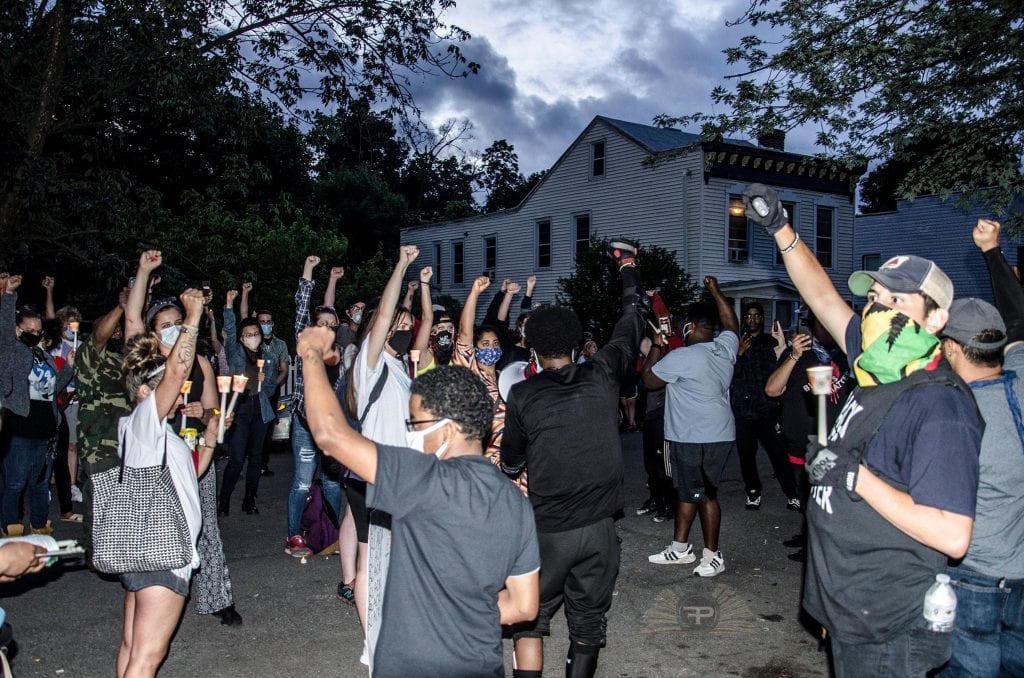
Forbes is shouting now. Granted, those weren’t the exact words out of John Koletas’ mouth and GBC will later attempt to use that against the young organizer. Forbes is animated; the words seem to come from his gut.
“Yet my people were oppressed for 400 years, and yet you see me and my team out here promoting peace for everyone! Unity, for everyone!”
The first major Black Lives Matter protest of this year in Albany on May 30 descended into rioting and looting. It’s still cited by local critics of the movement as a one-size-fits-all example of left-wing mayhem in the area. But ever since then, with significantly less coverage from traditional media, organizers like Forbes have held non-violent demonstrations aplenty and successfully de-escalated close encounters by both left- and right-wing trouble-makers.
The recordings from inside the church have been used as right-wing fodder for Kevin McCashion, a member of GBC and a local conservative provocateur on AM radio station WGY1300. He’s repeatedly blasted out information about Forbes’ employment with the city of Albany to a mass audience.
Since McCashion revealed Forbes’ personal information, Forbes’ office has reportedly received calls for his termination. Other protesters, like Negron, Brandon Brown, and Alex Stokes, Chris Canfield have also been exposed by McCashion across the internet.
Meet Brandon Brown.
— Grace Baptist Church (@realgbctroyny) July 17, 2020
Agitating “Peacekeeper”. Seen here disturbing a church service after agreeing to remain peaceful then shoving a church member. pic.twitter.com/LdZHFWjrf4
uh. oh.
— Kevin McCashion 🇺🇸 (@Kevin_McCashion) July 9, 2020
somebody in trouble?
“Because sentence against an evil work is not executed speedily, therefore the heart of the sons of men is fully set in them to do evil.” Ecclesiastes 8:11 KJV pic.twitter.com/5l5lTfqmgP
Meanwhile, those moments of violence have overnight turned the senior Koletas into a martyr for religious freedom for the alt-right as high-profile figures have praised GBC.
These right-wing media sources have, coincidentally, not delved very deep into the church’s politically and religiously fringe platform. They have not mentioned that Sunday and Monday’s tension was an exception to the mostly peaceful protests that have taken place in the Capital Region.
On July 6, Benny Johnson, a right-wing pundit who works for Turning Point USA, tweeted out a video of the tussle inside the foyer, calling the protesters “Violent BLM members” who “verbally and physically assaulted” what he called “peaceful Christians.”
Christians at Grace Baptist Church in Troy, NY we’re gathering to worship Sunday when BLM stormed their sanctuary and took over their church.
— Benny (@bennyjohnson) July 6, 2020
Violent BLM members stopped the service and assaulted the peaceful Christians verbally and physically.
WATCH:pic.twitter.com/GIwEMOFsBj
The Daily Wire published a story the next day and quoted a protester who attacked John Koletas on Sunday, June 28. The protester mocked him by saying, “how’s your head feel, pastor?” Glenn Beck’s The Blaze picked up the story as well, and Law Enforcement Today spun the story in the form of a pro-police screed.
Unlike the first giveaway in 2014, John Koletas has had few public press engagements. He spoke with PJ Media, a right-wing blog, calling the protesters “Marxist thugs.” PJ Media updated the story a day later after discovering GBC’s incendiary views. They reached back out to the pastor, who, unsurprisingly, defended his past rhetoric.
Hatred for Black Lives Matter activists has buoyed GBC’s notoriety. In alt-right circles, it’s a classic tale of leftist savages versus the righteous patriots defending their God and hearth. Showing up at the GBC, failing to keep protesters away from the congregation on the first day, and then entering the church on the second day was the highest-quality cut of red meat available for these right-wingers.
“At Grace Baptist Church in Troy, New Jersey (USA) protestors disrupt church service with profanity and violence while the pastor preaches the Gospel,” tweeted Brandon Beckham, a Christian lawyer, who mislocated the GBC. His tweet has since been deleted.
Now that his congregation is separated from the Black Lives Matter protesters, John Koletas leads his flock in a reading of scripture. Impassioned chants from the protesters radiate through the church walls, but it’s hard to hear.
The pastor had earlier, when the protesters were still in the building, preached a relatively palatable message of embracing Jesus. But now, he dips into a cauldron of doom-and-gloom. From members of law enforcement to politicians to clergy, he attacks “spineless cowards and traitors.” He has a special term reserved for the Pope: the Antichrist.
The tone inside is changing. Congregants are frozen in place as they listen to their preacher read biblical passages about weeping. Tears on John Koletas’ face glimmer in the soft glow, emanating from the hanging light fixtures in the hall.
The pastor says that it’s important to weep.
The mood takes a quick turn. Voices converge as congregants wait for the next step after they sing My Country ‘Tis of Thee together. It feels jovial and spirited like a bar trivia night.
It’s time for the AR-15 giveaway.
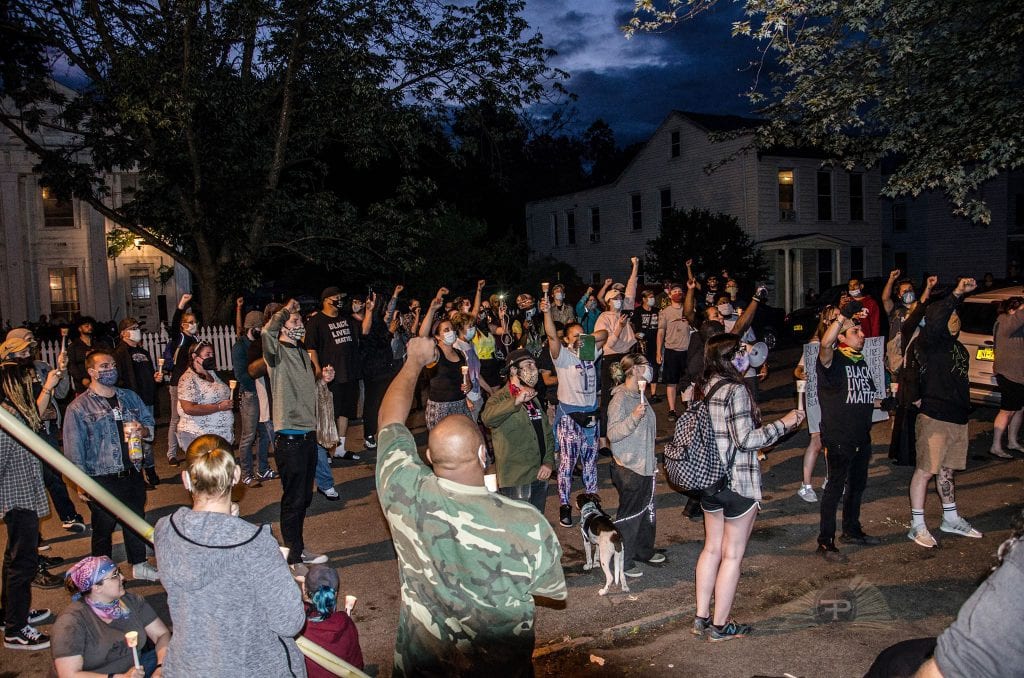
In a cheery tone, the pastor calls on a little girl to take a slip out of a large, woven basket. After lightly springing down the aisle, the child grabs the first name. The first name is George Koletas. The second name is John Koletas. The pastor jokes that the game must be rigged. The third name pulled is Sheryl Stevens.
As controversial as the contest has been across Lansingburgh, across Troy, and across the country, this moment feels light and happy; the lack of tension is deeply noticeable after having experienced so much of it just a half an hour before.
The peace and quiet weren’t going to last.
“If you wait five minutes, the police are going to have [protesters] across the street,” says John Koletas, and it’s the last thing he says to his gathered congregants into the mic.
The main room is shrouded in darkness after a church member flicks the light switch. The audience huddles in the foyer, speaking in small groups. A baby squeaks. At this point, the pastor dons a green beach hat. He holds what appears to be a blank, tired stare,
After five minutes it becomes apparent that the crowd’s not going to move across the street.
George Koletas raises his voice for the congregants’ attention. Police are going to escort members one vehicle at a time, he announces. “The mob is claiming that they’re also going to form a line to protect you, but obviously we know that’s not [true],” he says. “So be aware. Don’t talk to anybody.”
As the exit opens, a glowing sea of protesters holding candles emerges in the foreground. An orange beam from a nearby streetlight shines inside.
Police escort congregants out of the front door, person by person. Walking down the steps, a number of members have their heads facing away from the protesters like indicted celebrities walking out of a court hearing.
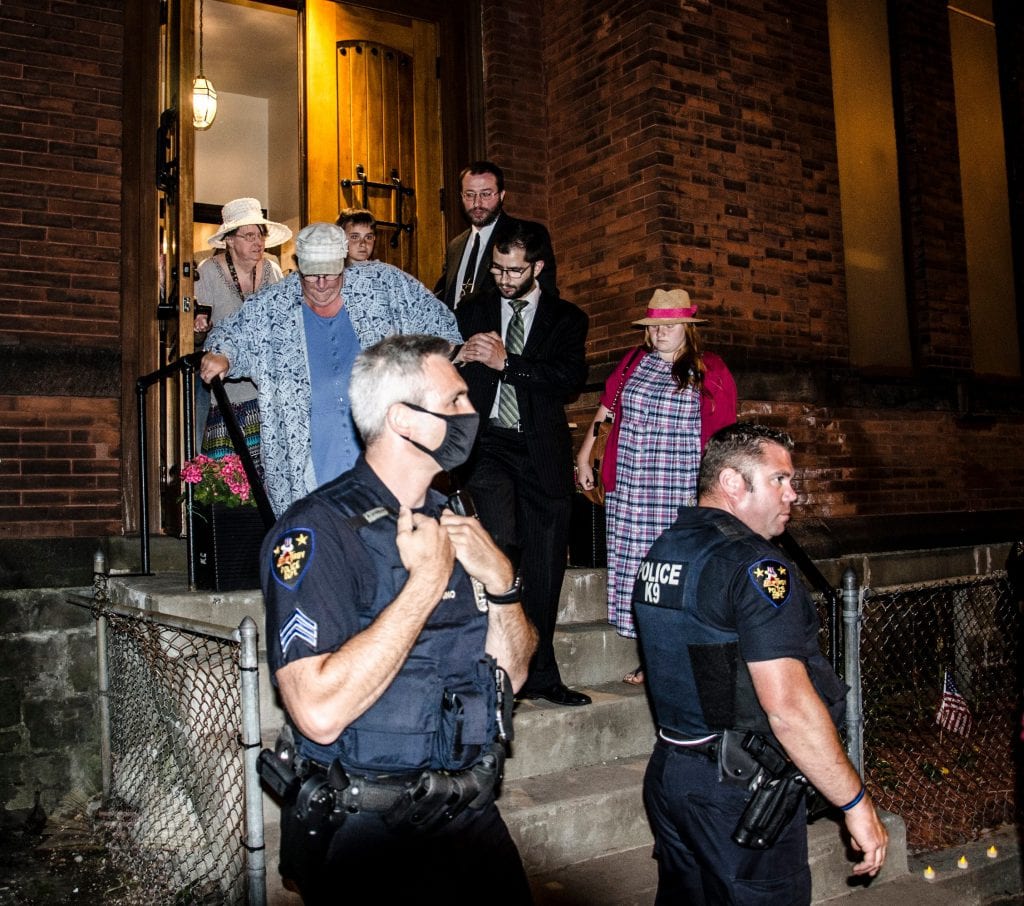
The vigil was the idea of Rhea Drysdale’s idea, a community activist and local business owner. After witnessing the chaos of the first protest outside the church and learning of a second AR-15 giveaway the next day, Drysdale wanted to send a different message. She contacted churches and synagogues for their support in order to hold a candlelight vigil outside the GBC.
“We wanted to say that this is intolerance,” Drysdale said in a later interview. “This is dangerous, it’s violent behavior. And so if we have a candlelight vigil on behalf of those who have been hurt and negatively affected by gun violence, then it puts something in everyone’s hands.”
With the major exceptions of the loud confrontations inside the church, that’s what the vigil was: a different message and a different mood. There was only one trickle of tension outside when a resident began raging about his hatred for GBC, interrupting Troy community leader Shaquana Smith, who had the megaphone and was reading selections of scripture.
Some organizers who are affiliated with Troy for Black Lives have since discouraged activists from fighting the organization without first having a foolproof plan, fearing antagonism and even violence as a potential repercussion for decision-making made on the fly.
Forbes isn’t looking to back off organizing against GBC anytime soon and the church hasn’t backed off Forbes. On social media, GBC has retweeted posts pointing to Forbes’ past criminal history when, at 15-years-old, he assisted a group that robbed and, in the process, nearly killed a gay man in Albany.
The 26-year-old community activist, now a rising leader in the Capital Region’s Black Lives Matter movement, deeply regrets his involvement in the crime, which landed him nine years in prison.
Does he regret going inside GBC?
“No,” he says in a later interview. “Because I was able to really see them for who they are.”
While it wasn’t part of her plan, Drysdale didn’t condemn protesters entering the church. She believes that church footage showed protesters in a vulnerable state. She also doesn’t like that the protesters were prohibited from recording, but that the GBC was recording them.
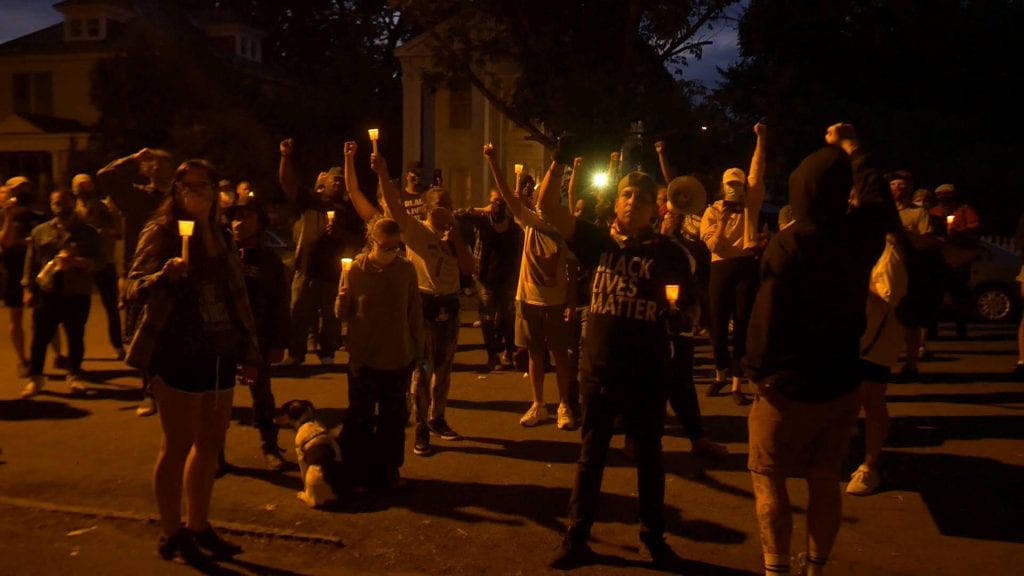
After learning about the pastor’s tragic past through his daughter’s podcast interview, Drysdale believes that the pastor is a “man in pain” and his pain is reflected in his incendiary sermons.
“Does it make what he says okay? Not at all.” Drysdale said. “But I don’t think that we have any chance of getting to him in a positive way if we don’t go through the church, because that’s what he needs.”
Additional reporting from Jaya Sundaresh
- Rt. 7 corridor gathering a blissful moment for seasoned organizer – April 19, 2021
- Emotions soar amid sudden, unfenced tree clearance in Lincoln Park – April 12, 2021
- Here’s how a superhighway changed one road in Rotterdam – August 11, 2020

